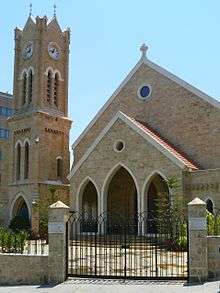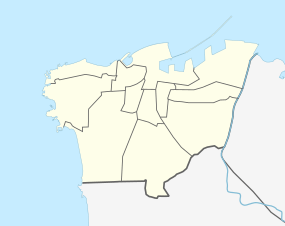National Evangelical Church of Beirut
| National Evangelical Church of Beirut | |
|---|---|
 | |
 The church shown within Beirut | |
| Basic information | |
| Location | Beirut, Lebanon |
| Geographic coordinates | 33°53′41″N 35°30′05″E / 33.894710°N 35.501477°ECoordinates: 33°53′41″N 35°30′05″E / 33.894710°N 35.501477°E |
| Affiliation | Protestant |
| Year consecrated | 1870 |
| Status | active |
| Specifications | |
| Direction of façade | North |
| Materials | Sandstone, limestone |
The National Evangelical Church of Beirut (NEC) is the first native Arabic Protestant congregation in the Middle East.
History
Established in the Lebanese capital, Beirut, in 1848 by Congregational and Presbyterian American missionaries, the NEC is the oldest and the largest of nine congregations situated outside Beirut in the towns of Abeih, Aramoun, Khaldeh, Kafarshima, Hadath, Dbayyeh, Jdeideh and Dhour el-Shweir.
The National Evangelical Church of Beirut is the headquarters and administrative centre of these nine churches which operate under the name of the National Evangelical Union of Lebanon (NEUL).
In 1870, the first Evangelical Church was built to house the Arabic and English speaking congregations. During the next hundred years, the church was the centre for all the activities and celebrations of both communities. Then during the Lebanese civil war (1975–1990) it was totally destroyed except for the bell tower and its congregation consequently scattered.
Since its reconstruction in 1998, the National Evangelical Church of Beirut has been standing again in the heart of Beirut's Central District, re-gathering its people with its worship services presided by Rev. Dr. Habib Badr as well as with its many socio-cultural and educational activities.
Today, the NEC runs two schools in Beirut and the Johann Ludwig Schneller School in the Western Beqaa District.[1] It is also involved in the ecumenical movement and theological education at the Near East School of Theology situated likewise in Beirut. Together with the Ecumenical Committee, it plays a leading role in assisting Sudanese refugees in Lebanon.
See also
References
- ↑ "About Johann Ludwig Schneller Schule". Johann Ludwig Schneller Schule. Retrieved 1 March 2012.
External links
- The National Evangelical Church of Beirut
- Johann Ludwig Schneller Schule
- Middle-East Council of Churches
- The Near East School of Theology
- Association of Churches and Missions in South Western Germany